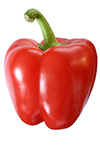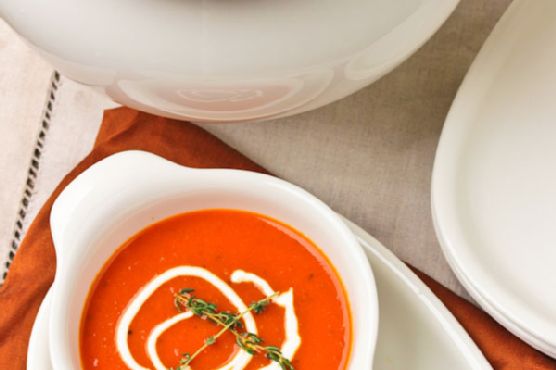Roasted Red Pepper Soup
Need a gluten free, dairy free, and lacto ovo vegetarian soup? Roasted Red Pepper Soup could be an outstanding recipe to try. This recipe serves 6 and costs $1.93 per serving. One serving contains 196 calories, 7g of protein, and 7g of fat. Plenty of people made this recipe, and 2128 would say it hit the spot. It is perfect for Autumn. A mixture of rice vinegar, salt, fresh thyme, and a handful of other ingredients are all it takes to make this recipe so scrumptious. From preparation to the plate, this recipe takes roughly 1 hour and 10 minutes. It is brought to you by A Spicy Perspective. Taking all factors into account, this recipe earns a spoonacular score of 99%, which is spectacular. If you like this recipe, take a look at these similar recipes: Roasted Red Pepper Soup, Roasted Red Pepper Soup, and Roasted Red Pepper Soup.
Servings: 6
Preparation duration: 25 minutes
Cooking duration: 45 minutes
Ingredients:
2 bay leaves
4 cups chicken stock (or vegetable broth)
2 large sprigs fresh thyme (1 Tb. leaves)
5 cloves garlic, in peel
½ tsp. ground pepper
1 tsp. hot sauce
2 Tb. olive oil
2 cups chopped onion
3 lbs. red bell peppers, halved and cleaned (8-10)
1-2 Tb. rice vinegar
½ tsp. salt
Equipment:
baking sheet
aluminum foil
oven
pot
immersion blender
kitchen towels
blender
Cooking instruction summary:
Half the peppers and remove all seeds and membranes. Press them flat with your hand and lay them on a foil lined, rimmed baking sheet. Place the garlic cloves on the baking sheet.Set the oven on broil and raise the rack to the upper position. Broil the red peppers and garlic for 15 minutes.Once the skin has blackened, remove from the oven and place in a large zip bag to steam. (10 minutes)Preheat a large pot to medium heat. Add the oil, thyme, bay leaves, and onions. Cook for 10 minutes, until onions are soft.Add the broth, hot sauce, salt and pepper. Squeeze the garlic cloves out of the peels into the pot.Then peel the charred skin off each pepper half and place it in the pot.Reduce the heat, cover and cook another 20 minutes. Remove the bay leaves and thyme sprigs. Then, using a hand-held immersion blender or standard blender, blend until smooth. *If using a blender, BE SURE TO remove the plug on the lid and cover with a kitchen towel—this with allow the heat to vent without a big mess!Add the vinegar and salt again if needed.Serve with extra thyme leaves. (In the photos I thinned out a little plain Greek yogurt with milk to make a fancy swirl on top. Pretty, but not necessary.)
Step by step:
1. Half the peppers and remove all seeds and membranes. Press them flat with your hand and lay them on a foil lined, rimmed baking sheet.
2. Place the garlic cloves on the baking sheet.Set the oven on broil and raise the rack to the upper position. Broil the red peppers and garlic for 15 minutes.Once the skin has blackened, remove from the oven and place in a large zip bag to steam. (10 minutes)Preheat a large pot to medium heat.
3. Add the oil, thyme, bay leaves, and onions. Cook for 10 minutes, until onions are soft.
4. Add the broth, hot sauce, salt and pepper. Squeeze the garlic cloves out of the peels into the pot.Then peel the charred skin off each pepper half and place it in the pot.Reduce the heat, cover and cook another 20 minutes.
5. Remove the bay leaves and thyme sprigs. Then, using a hand-held immersion blender or standard blender, blend until smooth. *If using a blender, BE SURE TO remove the plug on the lid and cover with a kitchen towel—this with allow the heat to vent without a big mess!
6. Add the vinegar and salt again if needed.
7. Serve with extra thyme leaves. (In the photos I thinned out a little plain Greek yogurt with milk to make a fancy swirl on top. Pretty, but not necessary.)
Nutrition Information:
covered percent of daily need
Related Videos:
Roasted Tomato and Red Pepper Soup Recipe















